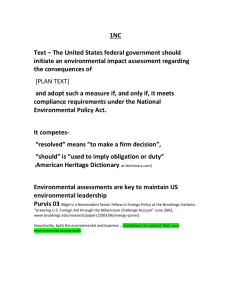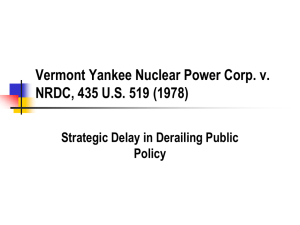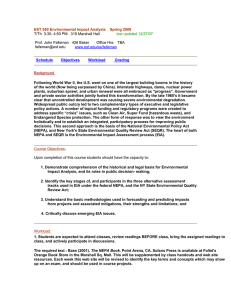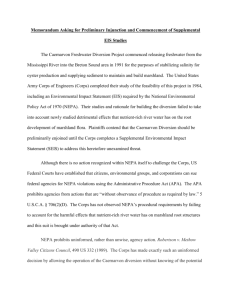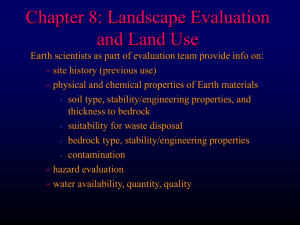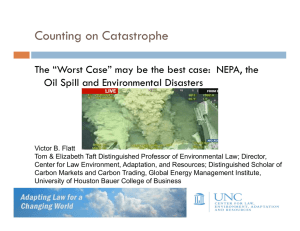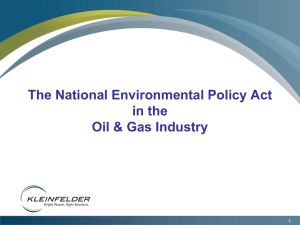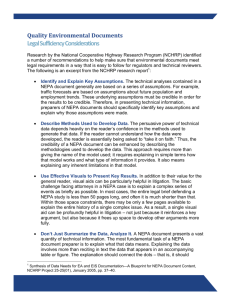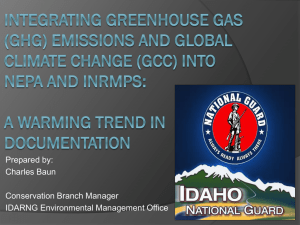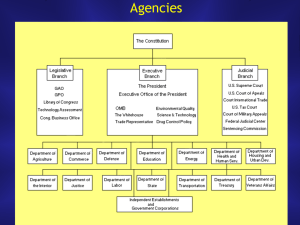nepa in the courts
advertisement
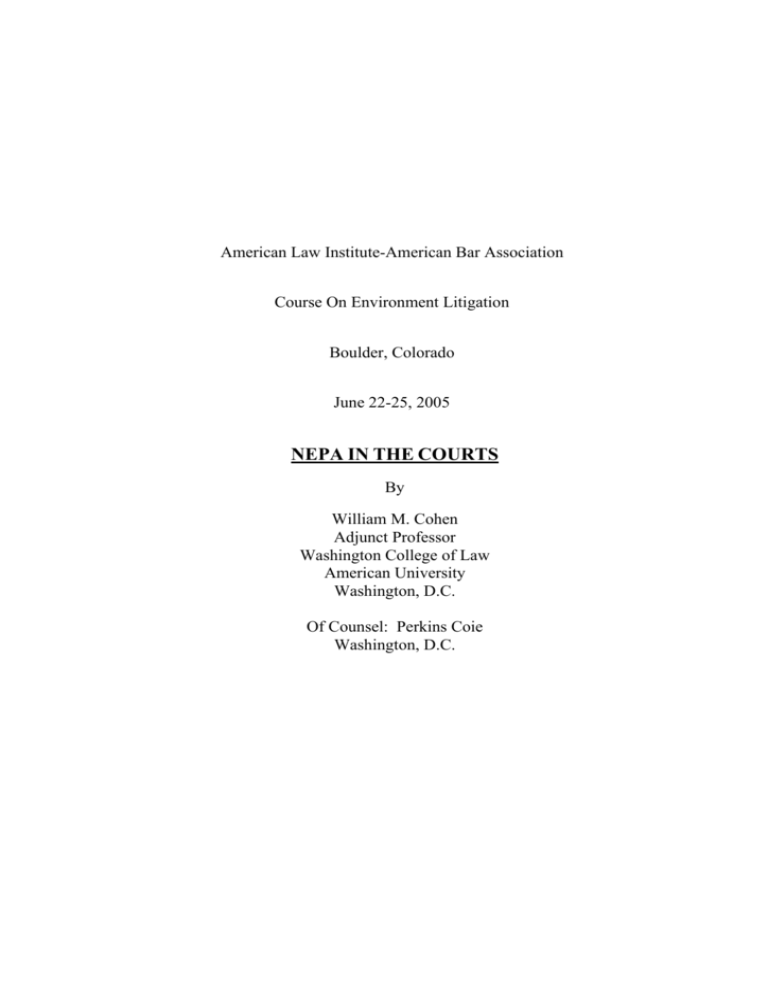
American Law Institute-American Bar Association Course On Environment Litigation Boulder, Colorado June 22-25, 2005 NEPA IN THE COURTS By William M. Cohen Adjunct Professor Washington College of Law American University Washington, D.C. Of Counsel: Perkins Coie Washington, D.C. TABLE OF CONTENTS I. RECENT SUPREME COURT RULINGS.................................................5 II. THE CHARACTER OF NEPA LITIGATION ..........................................7 A. Substantive goals, procedural duties ................................................7 Baltimore Gas & Elec. Co. v. NRDC, 462 U.S. 87 (1983)....................................8 B. (2) Threshold determination on whether to prepare an EIS, the FONSI and negative declaration, and categorical exclusions..........8 Categorical exclusions.................................................................................15 C. Controversy of a technical nature.....................................................17 D. Exemptions from NEPA: statutory, emergency, statutory conflict, functional equivalence .......................................................18 E. Is the activity "federal"? ...................................................................20 F. Non-action by the federal government.............................................23 G. Application of NEPA to legislative proposals .................................23 H. The time to prepare the EIS..............................................................27 I. Who must prepare the EIS?..............................................................30 J. Adequacy of the EIS; alternatives....................................................30 Vermont Yankee Nuclear Power Corp. v. NRDC, 435 U.S. 519 (1978). .............31 K. Programmatic EIS; scope of the EIS; divisibility of project or program. ...........................................................................................38 Baltimore Gas & Elec. Co. v. NRDC, 462 U.S. 87 (1983)....................................39 L. Assessment of socio-economic impacts in EISs. .............................40 -II- M. Extent of knowledge and information; research; worst case analysis. ............................................................................................42 N. Adverse comment by other agencies................................................44 O. Courts will not review draft EISs and advise what should go into prospective EISs; prematurity...................................................45 P. Agency Recovery of Costs of Preparing NEPA Documents from Applicants................................................................................46 Q. Application of NEPA to Events Abroad. .........................................47 R. The supplemental EIS. .....................................................................50 Id. at 370-385..........................................................................................................51 T. Cumulative Impacts, Ecosystem Analysis, and Biodiversity...........53 II. AFFIRMATIVE USE OF NEPA; AGENCIES BROADENING THEIR MANDATES ..................................................................................56 III. JUDICIAL REVIEW OF AGENCY DECISIONMAKING. .....................57 A. Standing, Ripeness, and Case or Controversy .................................57 Ohio Forestry Association, Inc. v. Sierra Club, 523 U.S. 726 (1998). ..................59 Id. at 84. ..................................................................................................................60 B. Scope and Standards of Review. ......................................................63 Vermont Yankee Nuclear Power Corp. v. NRDC, 435 U.S. 519 (1978). .............63 Baltimore Gas & Elec. Co. v. NRDC, 462 U.S. 87 (1983)....................................63 C. IV. No Private Right of Action to Enforce the Terms in the EIS. .........64 ADDITIONAL FACTORS IN LITIGATION STRATEGY......................68 A. Relief and Remedies.........................................................................68 B. Intervention--....................................................................................72 C. Discovery..........................................................................................74 -III- D. Exhaustion of Administrative Remedies, Primary Jurisdiction and Ripeness, Comments on Draft EISs. .........................................74 Vermont Yankee Nuclear Power Corp. v. NRDC, 435 U.S. 519 (1978). .............74 E. Limited Role of the Court in Looking at Conflicting Scientific Information Under NEPA. ...............................................75 F. Statute of Limitations .......................................................................76 G. Settlements .......................................................................................76 H. Preliminary Injunctions ....................................................................78 REFERENCES .......................................................................................................79 General: ..................................................................................................................79 CEQ Guidance:.......................................................................................................79 -IV- I. RECENT SUPREME COURT RULINGS In 2004, the Supreme Court decided two cases involving the National Environmental Policy Act (NEPA). They are Department of Transportation v. Public Citizen, 124 S. Ct. 2204, 159 L. Ed. 2d 60, 2004 U.S. LEXIS 4027 and Norton v. S. Utah Wilderness Alliance, 124 S. Ct. 2373, 159 L. Ed. 2d 137, 2004 U.S. LEXIS 4379. Public Citizen Department Of Transportation v. Public Citizen involved the Department of Transportation's issuance of regulations concerning the standards for the granting of Mexican truck operating authority in the United States. Prior to the promulgation of the regulations, Congress enacted a moratorium on Mexican motor carriers coming into the U.S. and gave the President the authority to lift the moratorium. As part of the North American Free Trade Agreement (NAFTA), the U.S. agreed to phase out the moratorium. The President announced his intention to lift the moratorium once the regulations were issued by Transportation. In the process of issuing the regulations, Transportation prepared an environmental assessment (EA) under the National Environmental Policy Act (NEPA) concluding that an environmental impact statement (EIS) was not required because the regulations would not have a significant environmental impact. Petitioners sued alleging violations of NEPA and the Clean Air Act (CAA). Among other things, petitioners argued that Transportation violated NEPA because the EA did not consider the environmental impact caused by the increased presence of Mexican trucks in the U.S. and that it violated the CAA because Transportation did not prepare a full conformity analysis.The Ninth Circuit held for petitioners and the Supreme Court reversed. Justice Thomas delivered the opinion for a unanimous Court. The Court's analysis focussed on Transportation's lack of discretion over the moratorium and its lifting. Without such discretion, neither NEPA nor the CAA requires it to consider the environmental impact of the lifting of the moratorium. As the Court said: "the relevant question is whether the increase in cross-border operations of Mexican motor carriers, with the correlative release of emissions by Mexican trucks, is an 'effect' of " the issuance of Transportation's rules. As for the Council on Environmental Quality's cumulative impact regulation, it does not require that the agency "treat the lifting of the moratorium itself, or consequences from the lifting of the moratorium, as an effect" of the Transportation rules. "We hold that where an agency has no ability to prevent a certain effect due to its limited statutory authority over the relevant actions, the agency cannot be considered a legally relevant 'cause' of the effect." Thus the agency need not consider these effects in its EA. -5-


